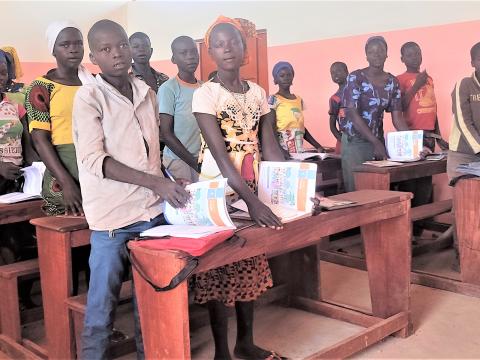Brand new classrooms for the children of Bologo

There is a studious silence this morning in the village of Maouya throughout our journey after we get off the asphalt. Even the animals seem to observe a time of silence as if something was happening.
Our colleague in charge of the education department, Bamé, tells us: "It's time for classes, all the children are in class, hence this quietness”. A moment later, behind the bushes, we hear the voices of the children repeating the teachers' lessons at the top of their voices. Their voices mingled with each other as if the classes were in competition. Finally, we see a large building with World Vision colours, a water point and latrines. A brand new building that meets the construction standards for schools in Chad.
It was with a smile on her face and enthusiasm that Dingara Celestine and her classmates, sitting two to a table, welcomed us. For her, it is a great first to study in such comfort.
"Before, we were on the ground and under a straw shed, where we were exposed to the weather. But thanks to World Vision Chad, now I study in a school that looks like the one I see on TV," explains the young girl from the first grade class of the school in Mboktol.
Further north of Mboktol, about three kilometers away, is the second school building in the village of Maouya. Here too, one can see on the children's faces the joy of attending in new and well-equipped classrooms and especially not far from their homes. As Zinedine Nicola, a student in the second year of middle school, testifies: "In addition to attending in a new classroom, the school is right in the village with a human power pump next door. We are truly the most blessed children in our province”.
Like Dingara Celestine and Zinedine Nicolas, 220 students from the villages of Mboktol and Maouya in the sub-prefecture of Bologo, Tandjilé province, have been studying in adequate conditions for the past few months thanks to buildings that meet the standards. These six classrooms and two management blocks were built with the community's contribution of local materials and the financial support of World Vision Taiwan. These classrooms can accommodate up to 300 students.